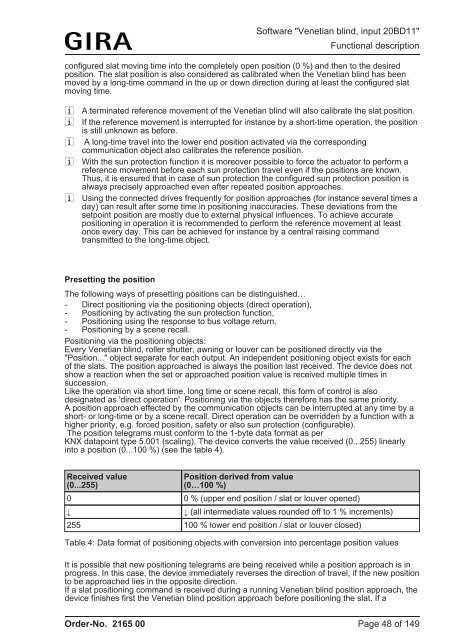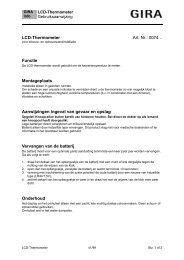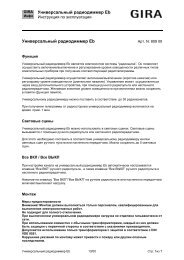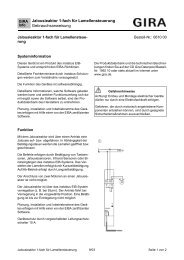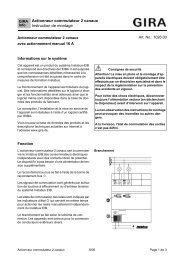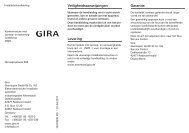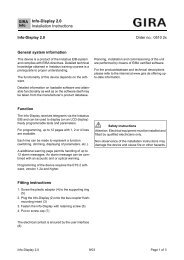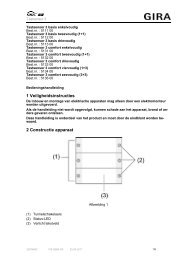Blind actuator 1-gang flush-mounted Order-No. 2165 00 - Gira
Blind actuator 1-gang flush-mounted Order-No. 2165 00 - Gira
Blind actuator 1-gang flush-mounted Order-No. 2165 00 - Gira
Create successful ePaper yourself
Turn your PDF publications into a flip-book with our unique Google optimized e-Paper software.
Software "Venetian blind, input 20BD11"<br />
Functional description<br />
configured slat moving time into the completely open position (0 %) and then to the desired<br />
position. The slat position is also considered as calibrated when the Venetian blind has been<br />
moved by a long-time command in the up or down direction during at least the configured slat<br />
moving time.<br />
i A terminated reference movement of the Venetian blind will also calibrate the slat position.<br />
i If the reference movement is interrupted for instance by a short-time operation, the position<br />
is still unknown as before.<br />
i A long-time travel into the lower end position activated via the corresponding<br />
communication object also calibrates the reference position.<br />
i With the sun protection function it is moreover possible to force the <strong>actuator</strong> to perform a<br />
reference movement before each sun protection travel even if the positions are known.<br />
Thus, it is ensured that in case of sun protection the configured sun protection position is<br />
always precisely approached even after repeated position approaches.<br />
i Using the connected drives frequently for position approaches (for instance several times a<br />
day) can result after some time in positioning inaccuracies. These deviations from the<br />
setpoint position are mostly due to external physical influences. To achieve accurate<br />
positioning in operation it is recommended to perform the reference movement at least<br />
once every day. This can be achieved for instance by a central raising command<br />
transmitted to the long-time object.<br />
Presetting the position<br />
The following ways of presetting positions can be distinguished…<br />
- Direct positioning via the positioning objects (direct operation),<br />
- Positioning by activating the sun protection function,<br />
- Positioning using the response to bus voltage return,<br />
- Positioning by a scene recall.<br />
Positioning via the positioning objects:<br />
Every Venetian blind, roller shutter, awning or louver can be positioned directly via the<br />
"Position..." object separate for each output. An independent positioning object exists for each<br />
of the slats. The position approached is always the position last received. The device does not<br />
show a reaction when the set or approached position value is received multiple times in<br />
succession.<br />
Like the operation via short time, long time or scene recall, this form of control is also<br />
designated as 'direct operation'. Positioning via the objects therefore has the same priority.<br />
A position approach effected by the communication objects can be interrupted at any time by a<br />
short- or long-time or by a scene recall. Direct operation can be overridden by a function with a<br />
higher priority, e.g. forced position, safety or also sun protection (configurable).<br />
The position telegrams must conform to the 1-byte data format as per<br />
KNX datapoint type 5.<strong>00</strong>1 (scaling). The device converts the value received (0...255) linearly<br />
into a position (0...1<strong>00</strong> %) (see the table 4).<br />
Received value<br />
(0...255)<br />
Position derived from value<br />
(0…1<strong>00</strong> %)<br />
0 0 % (upper end position / slat or louver opened)<br />
↓<br />
↓ (all intermediate values rounded off to 1 % increments)<br />
255 1<strong>00</strong> % lower end position / slat or louver closed)<br />
Table 4: Data format of positioning objects with conversion into percentage position values<br />
It is possible that new positioning telegrams are being received while a position approach is in<br />
progress. In this case, the device immediately reverses the direction of travel, if the new position<br />
to be approached lies in the opposite direction.<br />
If a slat positioning command is received during a running Venetian blind position approach, the<br />
device finishes first the Venetian blind position approach before positioning the slat. If a<br />
<strong>Order</strong>-<strong>No</strong>. <strong>2165</strong> <strong>00</strong><br />
Page 48 of 149


